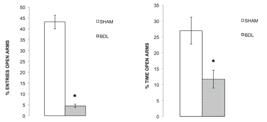Hepatic encephalopathy (HE) encompasses a variety of neuropsychiatric symptoms, including anxiety and psychomotor dysfunction. Although HE is a frequent complication of liver cirrhosis, the neurobiological substrates responsible for its clinical manifestations are largely unclear. In the present study, male Wistar rats were bile duct-ligated (BDL), a procedure which induces liver cirrhosis, and on the 21st day after surgery tested in the elevated plus-maze (EPM) and in an open field for anxiety and locomotor activity measurements. Analysis of Fos protein immunoreactivity (Fos-ir) was used to better understand the neurobiological alterations present in BDL animals. Plasma levels of ammonia were quantified and histopathological analysis of the livers was performed. BDL rats showed a significant decrease in the percentage of entries and time spent in the open arms of the EPM, an anxiogenic effect. These animals also presented significant decreases in Fos-ir in the lateral septal nucleus and medial amygdalar nucleus. Their ammonia plasma levels were significantly higher when compared to the sham group and the diagnosis of cirrhosis was confirmed by histopathological analysis. These results indicate that the BDL model induces anxiogenic results, possibly related to changes in the activation of anxiety-mediating circuitries and to increases in ammonia plasma levels.
anxiety; bile-duct ligation; Fos-immunoreactivity; hepatic encephalopathy; locomotor activity

 Thumbnail
Thumbnail
 Thumbnail
Thumbnail
 Thumbnail
Thumbnail
 Thumbnail
Thumbnail



